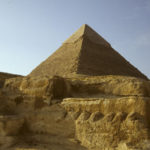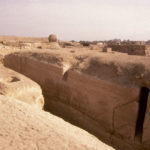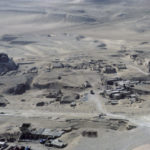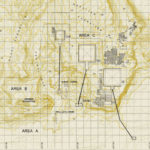How big of a hole do you have to dig to quarry enough rock to build a mountain? Pretty big when the mountain is the Great Pyramid, as Mark Lehner and David Goodman discovered when they surveyed the Great Pyramid quarry on the Giza Plateau.
They were impressed by the fearlessness the ancient builders exhibited in taking on such a colossal project. Surveying the yawning depression, they often imagined the clink-clink of the copper chisels and the thump of rock hammers of two thousand workmen toiling under the Giza sun. They could almost hear the rhythmic chanting of workers hauling the stones away on sledges.
A horseshoe-shaped quarry lies just south of Khufu’s Great Pyramid and the Khafre pyramid causeway. The sides of the quarry align with the sides of the Khufu Pyramid.
Lehner suspected that this great pit furnished most of the local stone for the core of the Great Pyramid. He calculated the missing volume of stone and compared the sum to the volume of the Great Pyramid (see MDAIK 41, 1985).
The ancient quarrymen began removing stone by cutting channels the size of hotel corridors to isolate big blocks of bedrock. They subdivided these blocks with smaller channels, just wide enough for a single quarryman to drive the channel forward.
When they isolated the desired-size block, they would insert levers as big as railroad ties into sockets along the underside and then pry the stone free from the bedrock. Once the stone was free they would drag it away. You can still see some of their channels and lever sockets.
Working this way, the pyramid builders cut the huge quarry to a maximum depth of 30 meters (98.4 feet) below the plateau surface.
The bottom of the quarry slopes slightly upwards to the north toward what would later become the Khafre causeway. Massive amounts of limestone, sand, tafla (desert clay), and gypsum debris now fill the center of the quarry. Lehner speculates this material might be remnants of the pyramid construction ramps, which the workers removed and dumped back into the quarry to fill it at the end of the project.
The largest blocks of bedrock, isolated by channels, still exist between the main quarry and the Sphinx to the east. Here you can see, roughed out of the bedrock but still attached, a 50-100 ton block like those the builders used in the Khafre and Menkaure temples.
In the quarry basin, which the builders exploited deeper into the bedrock, you can see channels and a stepped face that indicate where the ancient workmen cut the smaller pyramid-sized blocks in a one to two-ton range.
The calculation
To calculate the missing volume of stone in the quarry, we used a map from the Egyptian Ministry of Housing and Reconstruction (1977). This map has spot heights (measured elevations in meters above sea level) and contours at one-meter intervals.
Our calculation is an approximation because of the quarry’s irregular shape and the fact that centuries of blowing sand have refilled the southern extension of the quarry. A rough comparison with the Great Pyramid reveals a good match.
The estimated volumes for Khufu’s pyramid and the missing stone in his quarry are:
| Volume cubic meters | |
| Khufu pyramid | 2,590,000 |
| Khufu quarry | 2,760,000 |
The quarry is not precisely rectangular and the floor of the quarry is uneven, appearing to slope up to the north. The quarry’s southern outlet disappears beneath the sand-filled wadi situated between the Mokkatam and Maadi geological formations. Therefore, we do not know the entire length of the quarry in that direction.
The ancient quarrymen also wasted a certain amount of rock when channeling to extract the stone blocks. Master Carver Nick Fairplay estimated that this waste could have been 30%, perhaps more.
The quarry was mostly exploited before the second pyramid (Khafre, 2520-2494 BC) was built at Giza because Khafre’s children built tombs in the west walls of the quarry.
The size, location, and dating makes a good argument for identifying this big hole in the Mokkatam Formation as the Khufu quarry.
Other pyramid quarries at Giza
Menkaure (2490-2472 BC) built the third, or smallest, of the three principle Giza pyramids. American archaeologist, George Reisner, correctly identified a depression south-southeast of Menkaure’s pyramid as the quarry for that pyramid. It runs roughly southeast to northwest. Though we have not made a calculation of the volume, its size and location make it a likely candidate to be Menkaure’s pyramid quarry.
The Khafre quarry is less certain. Khafre (2520-2494 BC) may have quarried in several places at Giza. Part of his quarry may lie under the deep sand in the wadi south of the pyramids. Khafre may have also quarried tremendous amounts of stone in the area of his Sphinx (see see Khafre’s Sphinx) and from north of his pyramid causeway.
Seldom in the ancient world did humans so alter a landscape, what Kemp and O’Connor called (in reference to Birket Hapu, Amenhotep III’s manmade lake) “human disturbance on a geological scale.” It is little wonder that the world stands in awe of the accomplishments of the Giza pyramid builders.




